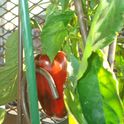What is the best method for soaking and storing dried (pinto) beans?
9 Comments
ChefJuneSeptember 12, 2014
I soak dried beans overnight or either all day. I neither salt the soaking water nor the cooking water.
I would not store soaked beans. After the beans are soaked, it's time to cook them.
I would not store soaked beans. After the beans are soaked, it's time to cook them.
trampledbygeeseSeptember 12, 2014
Personally, I'm not sure that I would store beans in their soaked state, at least not without worry and extra precautions. However I'm sure it can be done. You probably know most of what I'm about to write, but I'll start from basics for posterity sake.
Soaking beans wakes them up so to speak, going from a dormant state and starts the growing process. As dry they are exceptionally stable and perfect for storage. In the right conditions, they can stay that way for decades and still be good to eat/grow. When they are soaked and start to grow, the internal chemistry changes drastically - there are enzymes and carbs changing to sugars and all sorts of things happening as the bean prepares to send out it's sprout. This change is great for us, because it makes the beans so much more digestible. However, it's also not good because it creates an environment that negative bacteria and other invisible beasties can grow in if we aren't careful.
I don't know how it is in the States, but in the Great White North, one of the most dangerous commercial foods is bean sprouts. They are basically beans that have been soaked in a specific way so that they sprout (soaked, drained, rinsed, &c). It seems like every year there is a plethora of warnings and recalls from people getting sick. It's not the same as home-soaked beans, but hopefully it demonstrates the risk difference between dried and soaked beans being stored over time.
Time to focus on ways that soaked beans can be stored safely. My knowledge base is traditional, pre-industrial food storage methods, so hopefully someone up on the modern food safe doctrine can also chime in here.
You can keep the beans soaking for about 2 days, maybe twice that if you use a fridge, by changing the soaking water every 12 to 24 hours. This would allow the beans to stay soaked, and soft-ish.
I'm not confident enough to drain the soaked beans then put them in the fridge, because it would expose them to air and air-loving invisible beasties (aerobic bacteria, yeast, &c) are quicker at causing organic matter to decompose (compost) than anaerobic invisible beasties. Whereas storing it while it's soaking, would mean the beans are underwater and only have to deal with the non-air-loving invisible beasties. Since the environment in the soaked beans is already encouraging the breakdown of the bean into growing components (which are also yummy, yummy food for yeast, mold, &c.) it might be better to take it a step further and allow the beans to sprout before you store them. This would allow the new formed plant to consume a good portion of the invisible beasty food and re-stabilize it for storage.
Sprouts are super-yummy and nutritious. All those anti-nutrients in the bean are now easy to digest sugars and (this is already too long to get deep into the sciency stuff). Although there are no end of trouble with commercial sprouts, particularly linked to incorrect transport and storage; home grown sprouts are done in smaller batches and don't have to travel halfway across the continent to find their way to our table. Basically, it's easy to keep home sprouted beans safe.
So you could sprout them https://food52.com/blog... then store them in the fridge.
Or even better, you could sprout them, dry or roast them 'till completely dry, store them as you would dry beans, then cook/eat them later. They won't store as long sprouted, maybe only a month or so at room temp, longer in the freezer. However, the flavour of sprouted and roasted anyseed is FANTASTIC! Think malted barley. Beans are great this way too. You can even make a tasty flour. This is the most common traditional method for storing soaked bean/seeds/grains.
I also want to stress: Not all the invisible beasties are bad for us. But these days our immune systems aren't as strong as they were a few hundred years ago, so it's better to err on the side of caution.
Anyway, very curious to see what the modern doctrine has to say on the topic.
Soaking beans wakes them up so to speak, going from a dormant state and starts the growing process. As dry they are exceptionally stable and perfect for storage. In the right conditions, they can stay that way for decades and still be good to eat/grow. When they are soaked and start to grow, the internal chemistry changes drastically - there are enzymes and carbs changing to sugars and all sorts of things happening as the bean prepares to send out it's sprout. This change is great for us, because it makes the beans so much more digestible. However, it's also not good because it creates an environment that negative bacteria and other invisible beasties can grow in if we aren't careful.
I don't know how it is in the States, but in the Great White North, one of the most dangerous commercial foods is bean sprouts. They are basically beans that have been soaked in a specific way so that they sprout (soaked, drained, rinsed, &c). It seems like every year there is a plethora of warnings and recalls from people getting sick. It's not the same as home-soaked beans, but hopefully it demonstrates the risk difference between dried and soaked beans being stored over time.
Time to focus on ways that soaked beans can be stored safely. My knowledge base is traditional, pre-industrial food storage methods, so hopefully someone up on the modern food safe doctrine can also chime in here.
You can keep the beans soaking for about 2 days, maybe twice that if you use a fridge, by changing the soaking water every 12 to 24 hours. This would allow the beans to stay soaked, and soft-ish.
I'm not confident enough to drain the soaked beans then put them in the fridge, because it would expose them to air and air-loving invisible beasties (aerobic bacteria, yeast, &c) are quicker at causing organic matter to decompose (compost) than anaerobic invisible beasties. Whereas storing it while it's soaking, would mean the beans are underwater and only have to deal with the non-air-loving invisible beasties. Since the environment in the soaked beans is already encouraging the breakdown of the bean into growing components (which are also yummy, yummy food for yeast, mold, &c.) it might be better to take it a step further and allow the beans to sprout before you store them. This would allow the new formed plant to consume a good portion of the invisible beasty food and re-stabilize it for storage.
Sprouts are super-yummy and nutritious. All those anti-nutrients in the bean are now easy to digest sugars and (this is already too long to get deep into the sciency stuff). Although there are no end of trouble with commercial sprouts, particularly linked to incorrect transport and storage; home grown sprouts are done in smaller batches and don't have to travel halfway across the continent to find their way to our table. Basically, it's easy to keep home sprouted beans safe.
So you could sprout them https://food52.com/blog... then store them in the fridge.
Or even better, you could sprout them, dry or roast them 'till completely dry, store them as you would dry beans, then cook/eat them later. They won't store as long sprouted, maybe only a month or so at room temp, longer in the freezer. However, the flavour of sprouted and roasted anyseed is FANTASTIC! Think malted barley. Beans are great this way too. You can even make a tasty flour. This is the most common traditional method for storing soaked bean/seeds/grains.
I also want to stress: Not all the invisible beasties are bad for us. But these days our immune systems aren't as strong as they were a few hundred years ago, so it's better to err on the side of caution.
Anyway, very curious to see what the modern doctrine has to say on the topic.
trampledbygeeseSeptember 12, 2014
Yes, I know, I skipped over a lot of the sciency details and oversimplified greatly. It was already too long and the point is more to give people a starting place for thinking about the topic rather than an in depth treatise. My apologies to those who love the sciency thing (mostly to the part of my brain that is grumpy at me because I wrote in vernacular instead of specific science language.) I also omitted traditional methods that add specific molds, yeasts, bacteria &c to extend storage, change flavour, &c... far too complicated to go into at this stage.
creamteaSeptember 11, 2014
Sort the beans first, removing any foreign objects (stones, split beans). Then wash in several changes of water. Cover with cold water (I salt the soaking water and have had good results) and soak about 4 - 6 hours or overnight. Change the water prior to cooking; then cook till tender (I use salt, again, and a peeled onion with maybe a leaf of fresh bay). I wouldn't store/freeze them in a soaked-only state; I would freeze them after cooking, or keep them dry in the pantry. Buy from a source with lots of turnover to insure they are not too old.
trampledbygeeseSeptember 11, 2014
Could you clarify (because obviously I haven't had enough coffee). Are you asking how to store soaked beans? Or are you asking two questions, the best method to store dried beans and the best method to soak said beans?
NatalieSeptember 12, 2014
Sorry, I'm asking how to soak dried beans and then once they are soaked, how to store them...
NatalieSeptember 12, 2014
After I soak the beans, how do I cook them? Boil them for a few hours? After that process is done, can I then store them in the freezer or fridge?
trampledbygeeseSeptember 12, 2014
This article is really good: https://food52.com/blog... Some beans are ready in 20 min, some take 5 hours. It depends on the bean and how long since they were harvested - old beans take longer. My lazy method is to bring them to a full boil, then put it to a slow simmer and check on it every half hour or so. Seems to taste/texture better if I cook it slowly.
trampledbygeeseSeptember 12, 2014
Yes, after cooking you can store in the fridge for most of a week, or in the freezer for several months. If I'm storing in the fridge, I keep them in their cooking liquid. Let us know how your beans turn out.
Showing 9 out of 9 Comments
Recommended by Food52
Popular on Food52
Continue After Advertisement



